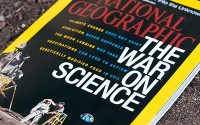By Creation Moments As you know, bats are able to find their way around and locate their prey using echolocation – high-pitched sounds that they also use to keep from flying into trees and other bats. But scientists have now learned that one particular kind of bat emits another call that warns other bats to stay away from bugs they’ve claimed for themselves. read more …read more Read more here: Creation Moments
By Ken Ham A number of anti-Christian trolls—seemingly they see their life’s mission as coming up with something negative to write about my posts. […] …read more Read more here: Ken Ham AIG
By Multimedia On this episode of ID the Future, Casey Luskin interviews Michael Behe on his peer-reviewed scientific paper in Quarterly Review of Biology. Dr. Behe explains why most examples of evolution in bacteria and viruses entail loss or modification of function rather than gain of a new function at the molecular level. In Behe’s view, this could pose a challenge to Darwinian explanations of molecular evolution. Your browser does not support playing Audio, please upgrade your browser or find our podcast on podOmatic Download Episode …read more Read more here: id the future
How to respond when someone tries to define the rules of the debate on their terms. …read more Read more here: creation.com
By Ken Ham Some imply AiG’s book Already Gone is based on a myth. Ken Ham responds to the false allegation and reveals research on the state of the church in America. …read more Read more here: AIG Daily
By Creation Moments Mechanical gears – like those found in clocks – have been around since the Greeks are thought to have invented them around 300 B.C. But scientists have now discovered a small hopping insect equipped with a set of living gears! read more …read more Read more here: Creation Moments
By Ken Ham Headlines are buzzing with news about the oldest known human in the fossil record. The specimen—half a lower jawbone with five teeth—was found in the […] …read more Read more here: Ken Ham AIG
Did Adam and Eve have navels, and the first trees have growth rings? Did God create light in transit from stars? What did Philip Gosse really teach? …read more Read more here: creation.com
A recent discovery indicates our eyelashes must measure at just the right length to function properly. Scientists at the Georgia Institute of Technology studied 22 mammal lash lengths and reported that, from giraffes to hedgehogs, lash length was of “optimum” length—about one-third of the width of the given mammal’s eye. More… …read more Read more here: icr.org
By Ken Ham What would George Washington have said about the Ark Encounter and our ongoing conflict with the State of Kentucky—and religious freedom as a whole in the US? …read more Read more here: AIG Daily
By radio@answersingenesis.org (Steve Ham) …read more Read more here: Answers Conversation
Who would have ever thought of storing information on segments of threaded strands according to a certain code? The Incas did-and they weren’t the first. …read more Read more here: creation.com
By Creation Moments How smart are Americans when it comes to science? That’s what the National Science Foundation attempts to find out every two years. The results of their 2014 survey – which included more than 2,200 adults – gave Americans a rather poor grade. But are Americans really less knowledgeable about science or is the NSF’s survey biased against the many Bible-believing Christians in America? Let’s take a look. read more …read more Read more here: Creation Moments
By Dr. Mark Bird The Bible clearly affirms the existence of three distinct Persons that are all identified as the one God of the universe. …read more Read more here: AIG Daily
How did nature supposedly transform a single-cell organism into all the varieties of land-walking animals in our world today? Textbook explanations invoke natural selection of beneficial mutations across unimaginable time, with a bit of help from “junk DNA” and heaps of serendipitous chance. Though it was not intended as a test of evolution, a new cancer research discovery jeopardizes these unfounded evolutionary assumptions. More… …read more Read more here: icr.org
By Multimedia On this episode of ID the Future, hear why the often-heard claim that intelligent design isn’t science is false, as Andrew McDiarmid explains the top reasons why ID is science. Your browser does not support playing Audio, please upgrade your browser or find our podcast on podOmatic Download Episode …read more Read more here: id the future
By Ken Ham What you believe about the past doesn’t just influence how you view the past—it also determines how you view the future! […] …read more Read more here: Ken Ham AIG
By Creation Moments Evolutionists tell us a 66-million-year-old feathered dinosaur resembling a giant demonic bird was discovered in the fossil-rich Hell Creek formation of South and North Dakota. Not surprisingly, this newly discovered dinosaur species was dubbed the “chicken from hell”. read more …read more Read more here: Creation Moments
A correspondent asks about how we view those who claim an asexual orientation. …read more Read more here: creation.com
The Bible is inerrant, yet some have tried to state that the Bible erroneously records 20 commandments. …read more Read more here: AIG Daily
High in the Andes, a furry member of the raccoon family has lived quietly for centuries without detection. …read more Read more here: AIG Daily
By Multimedia On this episode of ID the Future, hear Casey Luskin’s recent testimony in support of the South Dakota Academic Freedom Bill, SB114. Last month, the bill died in the Senate Election Committee by a vote of 4 to 2. Those who testified in favor of the bill include Dr. William Harris, a biochemist who holds a faculty position at the Sanford School of Medicine at the University of South Dakota, and Casey Luskin, the Research Coordinator at Discovery Institute. Your browser does not support playing Audio, please upgrade your browser or find our podcast on podOmatic <a class="colorbox" [More]
If Bill Nye says belief in biblical creation undermines science, why did his TV program unwittingly praise the work of a creation scientist? …read more Read more here: AIG Daily
Reaching more people in the Church is critical to spreading the creation message. …read more Read more here: creation.com
By Ken Ham A study was recently published that argues that “Humans are still evolving even though modern housing and sanitation, medical science and a rich and varied diet appear to have largely insulated much of the population from the life-or-death struggle of natural selection.” Apparently, this study concluded that, despite “falling death rates and a decrease in family size in the western world since the start of the industrial revolution 250 years ago,” human evolution is still going forward. Apparently humans are still evolving because “there is variation in the population in terms of reproduction” so there is “a [More]
By Ken Ham We recently received a heart-breaking but encouraging story that I would like to share with you. This testimony shows the practical importance of developing a trust in God’s Word from the very beginning. When hard times come, our feet need to be firmly planted in Scripture so that we can remain trustful and be comforted knowing that all of God’s promises are true. I want to let you know how grateful I am for your ministry. While your ministry is not new to me (I used your books and tapes when I homeschooled my children) it’s only [More]
A National Geographic article featuring the Creation Museum considers AiG science doubters, but the evidence always confirms the biblical creation account. …read more Read more here: AIG Daily






































